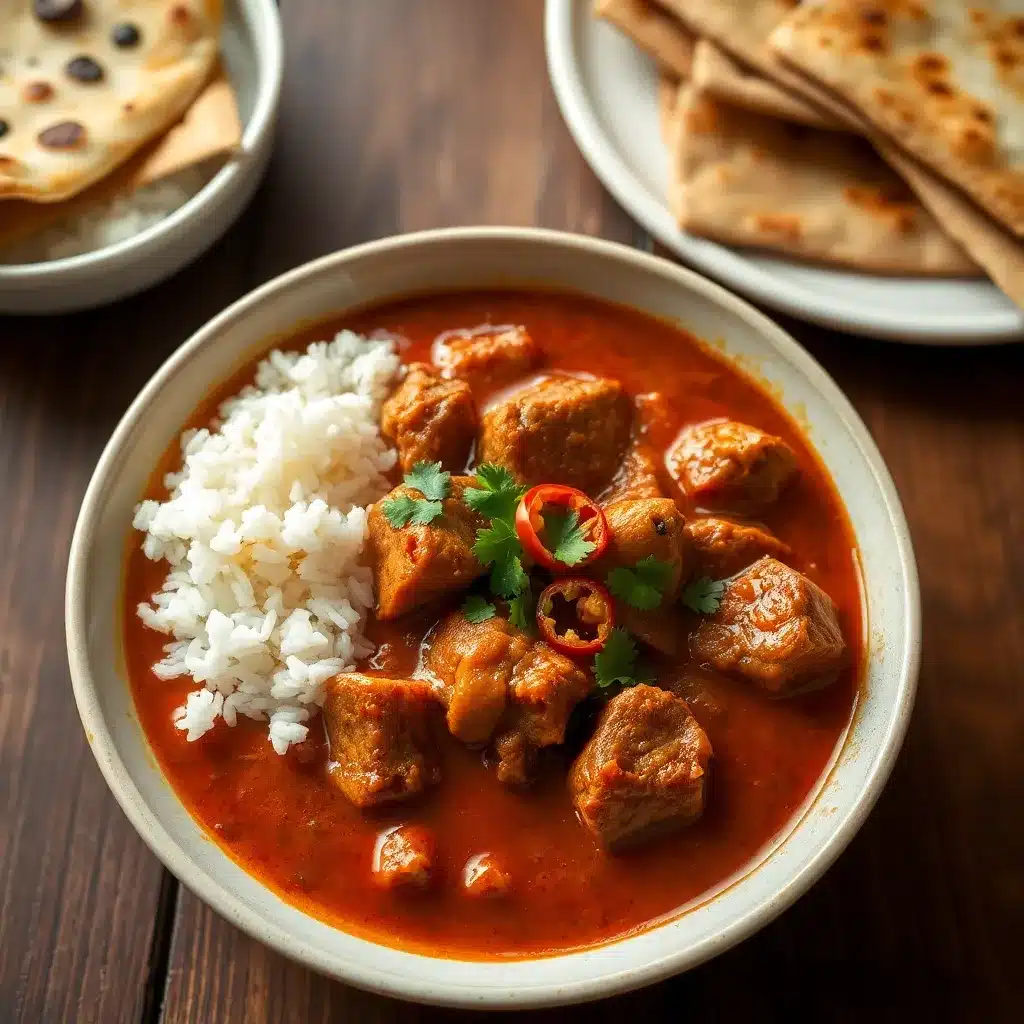Lamb Curry Recipe is one of those dishes that creeps into your memory and refuses to leave. I still remember the first time I had it as a kid—the air thick with the scent of cardamom, onions sizzling low and slow, and the heavy pot simmering away like it had no care in the world. Lamb curry is not just food—it’s history, it’s patience, it’s the sort of meal that gathers people without even asking.
Lamb Curry Recipe is special because it balances richness with spice in a way few dishes dare. The meat has a depth that chicken can’t quite mimic, and when paired with a spice base cooked properly, you get this sauce that clings, not runs. The beauty of lamb curry is that it’s humble, yet powerful enough to be the centerpiece of a feast.
Ingredients & Substitutions
Lamb Curry Recipe starts with lamb, obviously. Ideally, you’d use lamb shoulder or leg, something with enough fat to stand hours of cooking without turning stringy. If lamb is hard to find, goat works beautifully, but beef short ribs can hold their ground too.
Lamb Curry Recipe needs onions—lots of them. Yellow onions are common, but red onions bring a slightly sweeter note. Slice thin, because onions aren’t just a flavor—they form the sauce body. If onions are scarce, shallots or even leeks can step in, though the taste will shift.
Lamb Curry Recipe asks for garlic and ginger. Fresh, not jarred paste—those shortcuts flatten the vibrancy. Grind them into a rough paste. If ginger feels too sharp, mellow it out with roasted garlic cloves.
Lamb Curry Recipe spices can’t be faked. Whole cumin seeds, coriander, turmeric, cinnamon stick, black cardamom, cloves, and bay leaf. Toasted before grinding if you’re feeling extra. Pre-ground spices will work, but they lose half their perfume sitting on supermarket shelves for months.
Lamb Curry Recipe can handle tomatoes, but don’t drown it. Fresh ripe tomatoes give sweetness and body, while canned work fine if balanced with a touch of sugar. Some chefs swear by yogurt instead, which brings tang and helps tenderize.
Lamb Curry Recipe wouldn’t sing without chilies. Kashmiri red chili powder gives color and mild heat, while green chilies sliced lengthwise deliver sharp brightness. Adjust depending on tolerance. For no heat, paprika will give color without burning lips.
Lamb Curry Recipe loves fresh herbs at the end. Cilantro is classic, but fresh mint leaves bring a surprising lift. If cilantro tastes like soap to someone (yes, it happens), use parsley—it won’t bite back.
Step-by-Step Instructions
Lamb Curry Recipe begins with patience. Heat oil or ghee till it shimmers, then drop in whole spices—cloves, cinnamon, cardamom. Let them pop and crackle, releasing oils that flavor the fat. Skip this step, and your curry will taste flat no matter how many chilies you add.
Lamb Curry Recipe demands onions browned slowly. Don’t rush—caramelization builds the sweetness that balances spice. Stir often, don’t let them burn. If you go too dark, the curry turns bitter, and there’s no saving it.
Lamb Curry Recipe takes garlic and ginger next. Cook until the raw sharpness mellows. You’ll know by smell—it shifts from pungent to earthy sweet. Add your ground spices right after, blooming them in oil for just a minute. Do this too long, and you’ll scorch them, leaving bitterness.
Lamb Curry Recipe now welcomes lamb pieces, seared till edges brown. This sear isn’t just for looks—it seals juices and adds depth to the sauce. Crowding the pan will steam, not sear, so do it in batches.
Lamb Curry Recipe sauce is built with tomatoes or yogurt stirred in, then water or stock to loosen. Simmer gently, covered, until lamb turns tender. Low heat, long time—rush it, and the meat stays tough. For a quicker version, a pressure cooker cuts cooking time without losing flavor.
Lamb Curry Recipe finishing touches come with fresh chilies and herbs. Add them at the end, not earlier, so they keep their brightness. Taste the curry, adjust salt. Don’t fear salt—it’s what ties spice and richness together.
Cooking Techniques & Science
Lamb Curry Recipe works because of layering. Spices don’t just flavor—they bind with fat, creating an aromatic base that carries through the sauce. Fat is the highway for spice, without it, you’re left with sharp edges instead of depth.
Lamb Curry Recipe benefits from searing meat first. This isn’t about “locking juices” (that’s a myth). What actually happens is the Maillard reaction—the browning of proteins creating new, complex flavors. That brown crust translates directly into a richer sauce.
Lamb Curry Recipe shines when simmered slowly. Collagen in lamb shoulder melts into gelatin, turning the sauce silky and giving the meat tenderness. Cut cooking short, and you’re chewing rubber. Let it go long enough, and you barely need a knife.
Lamb Curry Recipe is flexible with cooking tools. A heavy-bottomed Dutch oven keeps heat steady, avoiding hot spots that scorch spices. Pressure cookers shorten time but need careful liquid adjustments. Nonstick pans? Forget it—they don’t caramelize onions the same way.
Serving & Pairing Suggestions
Lamb Curry Recipe deserves a stage. Serve it in a wide, shallow bowl, garnish with fresh cilantro leaves and maybe a drizzle of cream if you want elegance. Keep the garnish simple—the curry itself is already bold.
Lamb Curry Recipe pairs best with basmati rice, long-grain, fluffy, each grain separate. Naan or parathas are equally classic, perfect for scooping up sauce. If you want lightness, serve with cucumber raita to cool the palate.
Lamb Curry Recipe drinks best with bold pairings. A dry red wine like Shiraz handles the spice. Indian lager beers work beautifully. For non-alcoholic, chilled lassi with a hint of salt balances heat and richness.
Conclusion
Lamb Curry Recipe is more than just a meal—it’s time in a pot, spices blooming, onions melting, lamb tenderizing slowly till it gives in. It teaches patience, it rewards balance, and it proves why lamb holds such respect in culinary traditions worldwide.
Lamb Curry Recipe, when done right, is deeply personal. Every cook has their ratio of onions to tomatoes, their chili preference, their herb garnish. And that’s the beauty—you can bend it, shape it, adjust it, yet the essence remains the same: a rich, soulful curry.
Lamb Curry Recipe last tip: taste constantly. Spices shift as they cook, meat changes as it tenderizes, salt needs adjusting at the end. Cooking is less about rules, more about paying attention. That’s where the magic sits.
FAQs
How do I make lamb curry less spicy?
Lamb Curry Recipe can be mellowed by reducing chili powder and using paprika for color. A swirl of cream or yogurt at the end also balances heat.
Can I make lamb curry ahead of time?
Lamb Curry Recipe actually improves the next day. The flavors deepen overnight in the fridge, making it ideal for batch cooking or hosting.
What’s the best cut of lamb for curry?
Lamb Curry Recipe works best with shoulder, leg, or shank—cuts with connective tissue and fat. Avoid loin or chops, they dry out.
Can I cook lamb curry without tomatoes?
Lamb Curry Recipe doesn’t need tomatoes if you use yogurt or coconut milk instead. Each brings a different depth—yogurt adds tang, coconut milk adds sweetness.
How do I thicken lamb curry sauce?
Lamb Curry Recipe sauce thickens naturally if simmered uncovered. If still too thin, mash a few cooked potatoes or onions into the sauce to add body.

Olivia P. is a seasoned food blogger at Tastywink, sharing delicious, easy-to-follow recipes inspired by him passion for home cooking. With years of culinary blogging experience, he brings flavor, creativity, and a personal touch to every dish.
